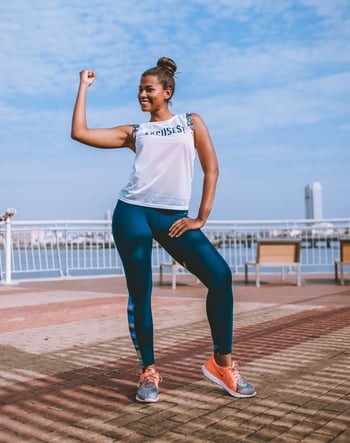 Summer is here.
Summer is here.
If you plan to spend any length of time enjoying the great outdoors — including the endless water activities — you’ll want to be in shape.
While being fit might mean looking fantastic in a bathing suit, it also means you’ll have better health, strength, and stamina to do the summer activities you love most.
Scared by the thought of working out? Never fear.
Even if you’ve never touched a dumbbell in your life, it doesn’t have to be overwhelming to get started working out. The biggest key is to take it slow and skip the crash diets.
This post will offer basic tips for getting in shape including finding consistency, starting slow, doing physical activity you love, and more.
Here we highlight seven exercise tips for beginners:
Start Your Workout Plan Now
It takes time to tone up and get in shape, especially if you haven’t been doing it regularly. Give yourself some grace, but know you’ll need to find daily motivation to see a difference. Everyone wants to get in shape for summer, and unfortunately there’s no crash diet that makes that happen.
It takes good old-fashioned sweat (and maybe some tears).
A few simple exercise tips for beginners:
- Setting goals and creating a plan helps keep you on track
- Making diet changes will help you reach your goals faster
- Listen to your body
- Don’t give up
Make meaningful changes for a healthier life, and you’ll be more likely to stick to your workout and diet routine.
1. Set Realistic Goals and Create an Action Plan
Determine how much you want to lose divided by weeks to see if the end result is feasible. If you hope to lose 50 pounds total, it’s not going to happen overnight. It takes time.
Some insight into setting fitness goals:
- 8-10 pounds a month is doable
- Count calories but don’t starve
- Find exercise activities that you enjoy
- Keep a journal to monitor progress
- Use a fitness app like The Wahoo 7-Minute Workout
Remember: Not everyone is interested in the same type of workout. You may also have health or physical limitations, so don't beat yourself up about what you can't do. Instead, learn how you can mix it up. Schedule workouts like your meetings or doctor appointments so that you stick with it.
2. Workout When it’s Easy to be Consistent
The best time to workout is not the same for everyone. We all have different work schedules and obligations. If you're really not a morning person, and you already don't like working out, don't schedule 5 a.m. workouts.
As you plan workouts, remember:
- Pick what works for you and your schedule
- Consistency is what gets results
- Location doesn’t matter; it’s whatever works best
Remember: Convenience and a time of day you’re most motivated are key to making your workouts consistent and productive. You can even workout at your desk!
3. Incorporate Diet Changes
Despite what the t.v. ads say or the magazines read, there's no magic pill that will give you a six-pack. As you gain confidence in working out, you may be tempted to still continue to eat junk food. Don’t fall into the trap of saying to yourself, “I’m working out so I can have that doughnut.” Look at your food triggers and find ways around them. For example, if you binge eat chips, you can’t eat those if you don’t buy them.
As you make diet changes:
- Bring your lunch and limit going out to eat
- Remember diet and exercise go hand in hand
- Identify your eating triggers
- Experiment with new recipes and foods
Remember: Healthy eating can be exciting. Note how you feel emotionally and physically after eating a healthy meal. Trying new foods can make it less of a “diet” and more of a new, fun meal experience. Once you pair diet and exercise together, you'll notice physical changes happen quicker — like strength, flexibility, weight loss, and more.
4. Stay Hydrated
The human body is mostly water, which means staying hydrated is a must. You want to make sure you're drinking plenty of water daily, especially when you're working out. Every single cell in your body needs water in order to work properly. Drinking water also flushes out toxins.
Easy ways to remember to drink more:
- Sip water throughout the day
- Dehydration can present as hunger
- Carry a reusable water bottle
- Take regular trips to the water cooler
- Drink water before, during, and after working out
Remember: Use the 8 by 8 rule. At a minimum, you’ll want to drink eight 8-ounce glasses of water per day. Up that amount when you’re vigorously working out. Staying hydrated can help regulate moods, improve focus, and keep you on track to your goal.
5. Listen to Your Body
Get your doctor's approval prior to starting any workout routine, especially if you have any underlying health concerns. You know your body better than anyone else. If you feel faint or weak at any time during workout, stop and take a break. You may be too dehydrated or pushing yourself too hard. Take a few moments to cool down before starting up again.
Listening to your body means you may have to:
- Ease into workouts
- Understand mild soreness is normal
- If you can barely move, take a break
- Find a mix of workouts to break up the week
Remember: Don’t forget to stretch! Static stretching can reduce your risk for injury. It can also help your body properly warm up and cool down.
6. If You Fall Off the Fitness Wagon, Get Back On
If you miss a couple of days (or more), don’t stop altogether. Think about all the hard work and time you've already put in. Muscle atrophy happens rather quickly, and you won’t want to lose your results. If you do stop for an extended amount of time due to illness, stress, etc., start up again as soon as you can.
Positive ways to jump back in:
- Tell yourself all is not lost and you’re not a failure
- Remember life gets in the way of your exercise sometimes
- Take inventory and pivot if you need to
- Try different things until you find something you enjoy
Remember: You don’t always have to be hardcore when you're working out to reap the benefits. Substitute other options if you can’t do your regular workout. Take a walk with a friend, do some gardening, or even take laps around the office or mall.
7. Pace Yourself
When you start working out, it can be easy to compare yourself to other people. They are on their own fitness journey just as you are on your own. Take your time in building your strength and confidence.
Pacing yourself means:
- Not getting discouraged
- Continuing healthy habits
- Implementing one change at a time
- Figuring out what works best for you
Remember: Monitor more than weight — take pictures and body measurements — other changes might be noticeable before the scale number moves.
Celebrate Your Fitness Wins
Once you start your workout journey, you don’t have to act as though you’re planning to enter a fitness competition the next day.
A healthy workout includes a good dose of cardio, strength training, and, of course, rest. If needed, enlist the help of a personal trainer to get going.
Any step toward learning how to get fit and healthy is a good one. Celebrate your milestones along the way, including any number of pounds or inches lost. You’ll also want to take note of how you feel.
Using the above exercise tips for beginners will also help you ease your way into this new fitness journey.
Journaling is a great way to record how you’re feeling mentally and physically as you make fitness improvements. Once you start seeing steady progress, it will further motivate you to keep up your active and healthy lifestyle.
Above all, do it for yourself. When you make it a point to set a fitness goal for yourself, it will feel more authentic and you’ll be more likely to stick with it through more than just the summer months.
How do you plan to get in shape for the summer? Share your plan in the comments below!



